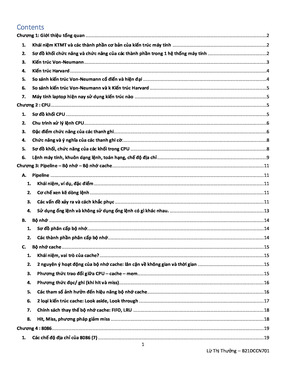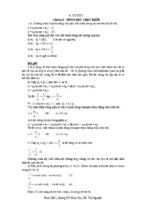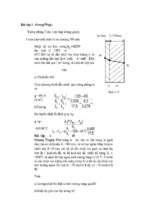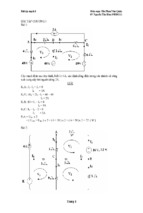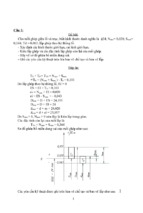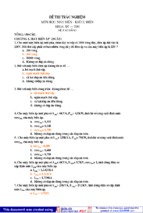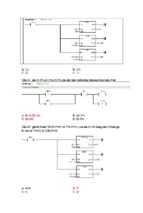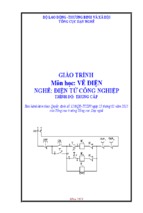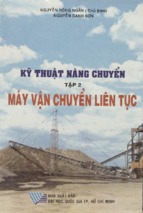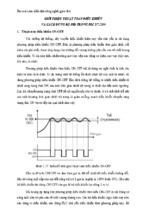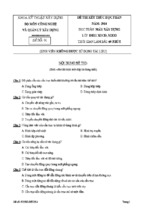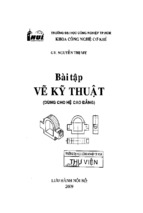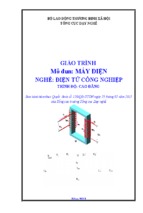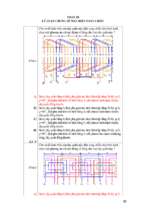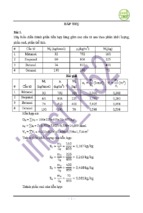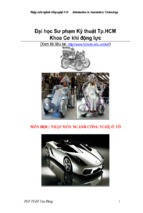Wax deposition đánh giá lắng đọng paraffin trong đường ống qua modeling
Wax Deposition
Experimental Characterizations,
Theoretical Modeling, and Field Practices
Emerging Trends and Technologies in
Petroleum Engineering
Series Editor
Abhijit Y. Dandekar
PUBLISHED TITLES:
Wax Deposition: Experimental Characterizations, Theoretical Modeling, and
Field Practices, Zhenyu Huang, Sheng Zheng, H. Scott Fogler
Wax Deposition
Experimental Characterizations,
Theoretical Modeling, and Field Practices
Zhenyu Huang
Sheng Zheng
H. Scott Fogler
Boca Raton London New York
CRC Press is an imprint of the
Taylor & Francis Group, an informa business
CRC Press
Taylor & Francis Group
6000 Broken Sound Parkway NW, Suite 300
Boca Raton, FL 33487-2742
© 2015 by Taylor & Francis Group, LLC
CRC Press is an imprint of Taylor & Francis Group, an Informa business
No claim to original U.S. Government works
Version Date: 20150408
International Standard Book Number-13: 978-1-4665-6767-2 (eBook - PDF)
This book contains information obtained from authentic and highly regarded sources. Reasonable
efforts have been made to publish reliable data and information, but the author and publisher cannot
assume responsibility for the validity of all materials or the consequences of their use. The authors and
publishers have attempted to trace the copyright holders of all material reproduced in this publication
and apologize to copyright holders if permission to publish in this form has not been obtained. If any
copyright material has not been acknowledged please write and let us know so we may rectify in any
future reprint.
Except as permitted under U.S. Copyright Law, no part of this book may be reprinted, reproduced,
transmitted, or utilized in any form by any electronic, mechanical, or other means, now known or
hereafter invented, including photocopying, microfilming, and recording, or in any information storage or retrieval system, without written permission from the publishers.
For permission to photocopy or use material electronically from this work, please access www.copyright.com (http://www.copyright.com/) or contact the Copyright Clearance Center, Inc. (CCC), 222
Rosewood Drive, Danvers, MA 01923, 978-750-8400. CCC is a not-for-profit organization that provides licenses and registration for a variety of users. For organizations that have been granted a photocopy license by the CCC, a separate system of payment has been arranged.
Trademark Notice: Product or corporate names may be trademarks or registered trademarks, and are
used only for identification and explanation without intent to infringe.
Visit the Taylor & Francis Web site at
http://www.taylorandfrancis.com
and the CRC Press Web site at
http://www.crcpress.com
Contents
Series Preface...........................................................................................................ix
Preface.................................................................................................................... xiii
Authors....................................................................................................................xv
1. Introduction......................................................................................................1
1.1 Background of Wax Deposition...........................................................1
1.2 Overview of Wax Testing, Modeling, and Management................. 5
2. Experimental Characterization of Important Wax
Thermodynamic Properties........................................................................... 9
2.1 Introduction............................................................................................ 9
2.2 Determination of the WAT................................................................. 10
2.2.1 Visual Inspection.................................................................... 12
2.2.2 CPM Techniques..................................................................... 14
2.2.3 Fourier-Transform Infrared Spectroscopy.......................... 17
2.2.4 Viscometry............................................................................... 19
2.2.5 Thermal Techniques—DSC................................................... 21
2.2.6 Comparison between Different WAT Measurements....... 26
2.2.7 Other Techniques That Are Under Development.............. 29
2.3 Determination of the WPC.................................................................30
2.3.1 Differential Scanning Calorimetry......................................30
2.3.2 Characterization of WPC Using NMR................................. 33
2.3.3 Characterization of WPC Using FT-IR.................................34
2.3.4 Separation-Based Methods for WPC Determination........ 35
2.4 Experimental Techniques for the Characterization of
Precipitated Wax.................................................................................. 38
2.5 Summary............................................................................................... 40
3. Thermodynamic Modeling of Wax Precipitation................................... 41
3.1 Introduction.......................................................................................... 41
3.2 Fundamental Thermodynamics of Wax Precipitation...................42
3.3 Step 1 in Thermodynamic Modeling: Construction of the
Thermodynamic Equations................................................................44
3.4 Step 2 in Thermodynamic Modeling: Simplification of
Thermodynamic Equations................................................................ 49
3.4.1 Wax Thermodynamic Models Assuming Single
Solid Phase............................................................................... 51
3.4.2 Wax Thermodynamic Models Considering Multiple
Solid Phases by Empirical Approaches: The Conoco
and Lira-Galeana Models...................................................... 55
v
vi
Contents
3.5
Coutinho’s Thermodynamic Model—A Theoretically
Comprehensive Thermodynamic Model.......................................... 56
3.6 Industrial Practice of Wax Thermodynamic Modeling.................. 58
3.6.1 Fluid Characterization: Preprocessing of
Thermodynamic Modeling................................................... 58
3.6.2 Model Tuning: Postprocessing of Thermodynamic
Modeling..................................................................................63
3.7 Extended Applications of Wax Thermodynamic Models..............64
3.8 Summary............................................................................................... 66
4. Wax Deposition Modeling........................................................................... 67
4.1 Wax Deposition Mechanisms............................................................. 67
4.2 Molecular Diffusion as the Main Mechanism for Wax
Deposition............................................................................................. 69
4.2.1 Step 1: Precipitation of Dissolved Wax Molecules............. 69
4.2.2 Step 2: Formation of Radial Concentration Gradient
of Dissolved Waxy Components........................................... 70
4.2.3 Step 3: Deposition of Waxy Components on the
Surface of an Existing Deposit.............................................. 71
4.2.4 Step 4: Internal Diffusion and Precipitation of Waxy
Components in the Deposit................................................... 71
4.3 Overview of Wax Deposition Modeling........................................... 73
4.3.1 Wax Deposition Modeling Algorithm................................. 73
4.3.2 Overview of Various Wax Deposition Models................... 74
4.3.2.1 Industrialized Commercial Wax Deposition
Models....................................................................... 74
4.3.2.2 Academic Wax Deposition Models....................... 75
4.4 Detailed Comparison of Different Wax Deposition Models......... 76
4.4.1 Model Dimensions.................................................................. 76
4.4.2 Hydrodynamics in the Wax Deposition Models................77
4.4.3 Heat Transfer Equations and Correlations.......................... 78
4.4.4 Mass Transfer and Deposit Growth Rate
Calculations for the Wax Deposition Models.....................80
4.4.4.1 Mathematical Representation of the
Molecular Diffusion Mechanism..........................80
4.4.4.2 Simplification of Wax Deposition Mechanisms.... 82
4.4.5 Determining the Mass Flux..................................................83
4.4.5.1 Diffusion Coefficient of Wax in Oil, Dwax............83
4.4.5.2 Difference in the Concentration of
Dissolved Waxy Components in the Bulk
Oil and at the Wall, (Coil − Cwall)............................84
4.4.5.3 Thickness of the Mass Transfer Layer,
δmass transfer.................................................................. 86
4.5 Summary............................................................................................... 90
Contents
vii
5. Introduction to Wax Deposition Experiments......................................... 91
5.1 Importance of Experimental Applications....................................... 91
5.2 Wax Deposition Flow Loop................................................................ 91
5.2.1 Conditioning System and Pump System............................. 91
5.2.2 Test Section.............................................................................. 93
5.3 Deposit Characterization.................................................................... 94
5.3.1 Measurement of the Deposit Thickness.............................. 94
5.3.1.1 Pressure-Drop Technique...................................... 94
5.3.1.2 Weight Measurement Technique.......................... 97
5.3.1.3 Heat Transfer Technique........................................ 97
5.3.1.4 Liquid Displacement–Level Detection
Technique............................................................... 100
5.3.1.5 Other Less Frequently Applied Techniques...... 100
5.3.2 Composition Analysis of the Wax Deposit....................... 101
5.4 Cold-Finger Wax Deposition Apparatus........................................ 103
5.5 Carrying Out Flow-Loop Wax Deposition Experiments............. 104
5.5.1 Setup of Experimental Apparatus...................................... 104
5.5.2 Oil Characterization............................................................. 105
5.5.3 Wax Deposition Tests........................................................... 105
5.5.4 Measurement of Deposit Thickness and
Characterization of Wax Deposits...................................... 105
6. Applying Wax Deposition Models to Flow Loop Experiments......... 107
6.1 Introduction........................................................................................ 107
6.2 Uncertainties in Wax Deposition Modeling................................... 107
6.2.1 Characterizing the Wax Precipitation Curves.................. 108
6.2.2 Empirical Correlations for Transport Phenomena........... 108
6.2.3 Uncertainties in Experimental Measurements................. 109
6.2.4 Appropriate Methodology for Wax Deposition
Benchmarking....................................................................... 109
6.3 Applying Wax Deposition Models with Deposit Thickness....... 110
6.3.1 Selecting Wax Deposition Experiments............................ 110
6.3.1.1 Experimental Facility............................................ 110
6.3.1.2 Test Oil.................................................................... 110
6.3.1.3 Experimental Conditions..................................... 111
6.3.2 Summary of Model Performance....................................... 114
6.4 Heat and Mass Transfer Analysis of the Wax Deposition
Experiments........................................................................................ 117
6.4.1 Previous Wax Deposition Experiments on the Effect
of Temperature...................................................................... 117
6.4.2 Theoretical Analysis............................................................. 118
6.4.2.1 Dedimensionalizing the Transport Equations.... 118
6.4.2.2 Characteristic Mass Flux of Wax Deposition.... 120
6.4.2.3 Mass Transfer Driving Force............................... 121
viii
Contents
6.4.3
Effect of the Operating Temperatures............................... 122
6.4.3.1 Analysis on the North Sea Condensate............. 122
6.4.3.2 Analysis on Another Oil...................................... 123
6.4.3.3 Importance of the Wax Precipitation Curve...... 125
6.4.3.4 Carbon Number Distribution of the Oil............ 126
6.5 Applying Wax Deposition Models to Investigate Deposit
Compositions...................................................................................... 127
6.6 Summary............................................................................................. 129
7. Applying Wax Deposition Models for Field Predictions.................... 131
7.1 Introduction........................................................................................ 131
7.1.1 Wax Control Strategies for the Field.................................. 131
7.1.2 Evaluating the Severity of Wax Deposition: The Ideal
vs. the Reality........................................................................ 133
7.2 Example 1—Single-Phase Pipe Flow............................................... 134
7.2.1 Introduction........................................................................... 134
7.2.2 Wax Thermodynamic Characterizations.......................... 135
7.2.3 Deposition Predictions and Pigging Frequency
Design....................................................................................136
7.3 Example 2—Gas/Oil Flow................................................................ 140
7.3.1 Introduction........................................................................... 140
7.3.2 Wax Thermodynamic Characterization............................ 141
7.3.3 Deposition Predictions and Pigging Frequency
Design................................................................................. 143
7.4 Summary............................................................................................. 145
7.4.1 Wax Thermodynamic Characterizations.......................... 145
7.4.2 Wax Deposition Modeling................................................... 146
7.5 Future Outlook................................................................................... 146
7.5.1 Improving Field Characterization Techniques................. 147
7.5.2 Collaboration between Industrial Partners....................... 147
7.5.3 Develop More Rigorous Wax Deposition Modeling
for Multiphase Flow Conditions......................................... 147
Bibliography......................................................................................................... 149
Appendix A: Nomenclature.............................................................................. 159
Index...................................................................................................................... 163
Series Preface
This petroleum engineering book series includes works on all aspects of
petroleum science and engineering but with special focus on emerging
trends and technologies that pertain to the paradigm shift in the petroleum engineering field. It deals with the increased exploitation of technically challenged and atypical hydrocarbon resources that are receiving a lot
of attention from today’s petroleum industry, as well as the potential use
of advanced nontraditional or nonconventional technologies such as nanotechnology in diverse petroleum engineering applications. These areas have
assumed a position of prominence in today’s petroleum engineering field.
However, although scientific literature exists on these emerging areas in the
form of various publications, much of it is scattered and highly specific. The
purpose of this book series is to provide a centralized and comprehensive
collection of reference books and textbooks covering the fundamentals but
paying close attention to these emerging trends and technologies from the
standpoint of the main disciplines of drilling engineering, production engineering, and reservoir engineering.
Given the dwindling supply of easy-to-produce conventional oil, rapidly
climbing energy demands, the sustained ~$100/bbl. oil price, and technological advances, the petroleum industry is increasingly in pursuit of
exploration and production (E&P) of atypical or unconventional and technically challenged oil and gas resources, which may eventually become
the future of the petroleum industry. Unconventional resources typically
include (1) coal bed methane (CBM) gas; (2) tight gas in ultralow permeability formations; (3) shale gas and shale oil in very low permeability shales;
(4) oil shales; (5) heavy and viscous oils; (6) tar sands; and (7) methane
hydrates. Compared to the world’s proven conventional natural gas reserves
of 6600+ trillion cubic feet (TCF), the combined CBM, shale gas, tight gas, and
methane hydrate resource estimates are in excess of 730,000 TCF.1–3 Similarly,
out of the world’s total of 9 to 13 trillion bbl. of oil resources, the conventional (light and medium oil) is only 30%, whereas heavy oil, extra-heavy oil,
tar sands, and bitumen combined make up the remaining 70%.4 In addition
shale-based oil resources worldwide are estimated to be between 6 and 8 trillion bbl.5 As a case in point, shale-based oil production in North Dakota has
increased from a mere 3000 bbl./day in 2005 to a whopping 400,000+ bbl./day
in 2011.6 Even the most conservative technical and economic recovery estimates of the unconventional resources represent a very substantial future
energy portfolio that dwarfs the conventional gas and oil reserves. However,
to a large extent, these particular resources, unlike the conventional ones, do
not fit the typical profile and are to some extent in the stages of infancy, thus
ix
x
Series Preface
needing a different and unique approach from the drilling, production, and
reservoir engineering perspectives.
The petroleum engineering academic and industry community is also
aggressively pursuing nanotechnology with the hope of identifying innovative solutions for problems faced in the overall process of oil and gas recovery.
In particular, a big spurt in this area in the last decade or so is evident from
the significant activities in terms of research publications, meetings, formation
of different consortia, workshops, and dedicated sessions in petroleum engineering conferences. A simple literature search for a keyword nanotechnology
on http://www.onepetro.org, managed by the Society of Petroleum Engineers
(SPE), returns over 250 publications dating from 2001 onward with the bulk
of them in the last 5 or 6 years. Since 2008, SPE also organized three different applied technology workshops specifically focused on nanotechnology in
the E&P industry. An Advanced Energy Consortium with sponsorships from
some major operators and service companies was also formed in 2007 with the
mission of facilitating research in “micro and nanotechnology materials and
sensors having the potential to create a positive and disruptive change in the
recovery of petroleum and gas from new and existing reservoirs.” Companies
such as Saudi Aramco have taken the lead in taking the first strides in evaluating the potential of employing nanotechnology in the E&P industry. Their
trademarked ResbotsTM are designed for deployment with the injection fluids for in situ reservoir sensing (temperature, pressure, and fluid type) and
intervention, eventually leading to more accurate reservoir characterization
once fully developed. Following successful laboratory core flood tests, they
conducted the industry’s first field trial of reservoir nanoagents.7
The foregoing is clearly a statement of the new wave in the petroleum
engineering field, which is being created by emerging trends in unconventional resources and new technologies. The publisher and its series editor are
fully aware of the rapidly evolving nature of these key areas and their longlasting influence on the current state and future of the petroleum industry.
The series is envisioned to have a very broad scope that includes but is not
limited to analytical, experimental, and numerical studies and methods and
field cases, thus delivering readers in both academia and industry an authoritative information source of trends and technologies that have shaped and
will continue to impact the petroleum industry.
References
1. Retrieved from http://www.eia.gov/analysis/studies/worldshalegas/ (accessed
date June 10, 2013).
Series Preface
xi
2. Kawata, Y. & Fujita, K. Some predictions of possible unconventional hydrocarbons availability until 2100. Society of Petroleum Engineers (SPE) paper number 68755. SPE Asia Pacific Oil and Gas Conference and Exhibition, 17–19 April,
Jakarta, Indonesia.
3. Retrieved from http://www.netl.doe.gov/kmd/cds/disk10/collett.pdf. Methane
Hydrates Interagency R&D Conference, 20–22 March 2002, Washington, DC.
4. Retrieved from https://www.slb.com/~/media/Files/resources/oilfield_review
/ors06/sum06/heavy_oil.ashx
5. Biglarbigi, K., Crawford, P., Carolus, M. & Dean, C. Rethinking world oil–shale
resource estimates. Society of Petroleum Engineers (SPE) paper number SPE
135453. SPE Annual Technical Conference and Exhibition, 19–22 September,
Florence, Italy.
6. Mason, J. Retrieved from http://www.sbpipeline.com/images/pdf/Mason
_Oil%20Production%20Potential%20of%20the%20North%20Dakota%20
Bakken_OGJ%20Article_10%20February%202012.pdf
7. Kanj, M. Y., Rashid, M.H. & Giannelis, E.P. Industry first field trial of reservoir
nanoagents. Society of Petroleum Engineers (SPE) paper number SPE 142592.
SPE Middle East Oil and Gas Show and Conference, 25–28 September, Manama,
Bahrain.
Abhijit Dandekar
University of Alaska Fairbanks
Preface
Wax deposition has become one of the most common flow assurance problems in the petroleum industry. As petroleum resources shift from onshore
reservoirs toward offshore subsea production, the industry is currently facing unprecedented challenges to maintain flow assurance for petroleum
production, in which the strategy to prevent or mitigate wax deposition has
become increasingly costly and complicated.
The goal to manage the issue of wax deposition involves answering the
following three questions:
• Do we have a problem for this field?
• If yes, what kind of a problem is it? How bad is it?
• How can we solve this problem?
They are typical questions to be answered not only for wax-related issues
but also for a variety of many other common production chemistry problems
in general flow assurance practices. The answer to the first question generally involves only a few fluid testing procedures that are relatively simple,
while much more understandings on production chemistry and fluid flow
are required to address the second question. The answer to the third question requires not only knowledge that are shown in chemical engineering
textbooks but also significant operational experience, and the decision makers have to fully understand the production capability of the field and the
effectiveness as well as implication of any mitigation/remediation methods.
While there are several books that provide general knowledge on flow
assurance, a book that specifically addresses the issue of wax deposition is
still not yet available. This book is the first one that covers the entire spectrum of knowledge on wax deposition phenomena. It provides a detailed
description of the thermodynamic and transport theories for wax deposition modeling and a comprehensive review of the laboratory testing to help
establish appropriate control strategies for the field. It provides a progressive
introduction to help flow assurance engineers to understand the process of
wax deposition, to be familiar with the various methods to identify its severity, and to eventually control this problem. For engineering students, practicing engineers, and researchers in the field of flow assurance, this book serves
as an in-depth discussion of how fundamental principles of thermodynamics, heat, and mass transfer can be applied to solve a problem common to the
petroleum industry.
Going back to the three key questions that were raised earlier in this
Preface, we hope to provide valuable information in this book that could help
the readers to address these questions. Chapter 1 presents the background
xiii
xiv
Preface
of wax deposition, including the cause of the phenomena, the magnitude
of wax deposition problems, as well as its impact on petroleum production.
Chapters 2 and 3 introduce various laboratory techniques and theoretical
models. These testing and modeling are indispensable to address the first
question (Do we have a wax problem?). Chapters 4–6 present the knowledge
that is critical to answer the second key question (How bad is the problem?).
In Chapter 4, a systematic presentation will be made to describe the process
of wax deposition using chemical engineering fundamentals. It discusses
various models of wax deposition and analyzes the differences between the
assumptions used in these models. In addition, the advantages and disadvantages in each model are compared. Chapter 5 provides a detailed description of how to conduct laboratory wax deposition experiments in order to
benchmark different wax deposition models. In this chapter, the applications of the cold finger apparatus and the lab scale flow loop are highlighted.
Chapter 6 discusses examples of how fundamental principles of heat and
mass transfer can be applied to interpret laboratory wax deposition experiments to better understand wax deposition behaviors and eventually predict
the wax deposit growth in field operations. Chapter 7 brings the readers to
the “real world” by providing several field examples of how management
strategies for wax deposition in the field can be established based on the
available laboratory testing and modeling work, thereby addressing the
third question (How can we solve the problem?).
This book contains comprehensive knowledge of wax deposition not only
from academic research but also from the flow assurance industry, thanks
to the comments and suggestions from many petroleum companies in the
industry. We acknowledge Tommy Golczynski and Tony Spratt from Assured
Flow Solutions LLC for carefully reviewing the drafts of the book. We thank
all the sponsors of the University of Michigan Industrial Affiliates Program,
including Chevron, ConocoPhillips, Multichem, Nalco, Shell, Statoil, Total,
and Wood Group Kenny. In addition to their financial support to the academic research to the Michigan Industrial Affiliates Research Program, the
expertise and experience shared by the representatives of these companies
constitute an integral part of the completion of this book. We also thank all
the members of Professor Fogler’s research group for their effort dedicated to
the Michigan Industrial Affiliates Research Program. Finally, we extend our
gratitude to our family members for their support in completing this book.
Authors
Dr. Zhenyu Huang (Jason) is currently a senior flow
assurance specialist in Assured Flow Solutions LLC,
providing engineering solutions for a variety of flow
assurance issues to the petroleum industry. His expertise
includes production chemistry and multiphase flows. Dr.
Huang has more than 8 years of academic and industrial experience focused extensively on a variety of
wax deposition problems. His work includes model
development, experimental verifications, fluid testing and field applications. He has been involved with
multiple offshore developments that present wax deposition/gelation concerns. He is the subject matter expert on wax-related issues, and he currently
serves as the vice president of the Upstream Engineering and Flow Assurance
Section of the American Institute of Chemical Engineers. Dr. Huang earned
his bachelor’s degree in Tsinghua University in Beijing, China, in 2006, and
he completed his PhD study at the University of Michigan, Ann Arbor in 2011
with a thesis entitled “Application of the fundamentals of heat and mass transfer to the investigation of wax deposition in subsea pipelines.”
Sheng Zheng (Mark) graduated summa cum laude from
the University of Michigan with a bachelor’s degree in
chemical engineering and minors in chemistry and
mathematics. He is currently a doctoral candidate in
Professor Fogler’s research group, specializing in both
cutting-edge experimental characterizations and theoretical modeling for wax deposition research. He has
multiple high-quality publications focusing on compositional wax deposition modeling and wax transport in
multiphase flow conditions. Together with Dr. Huang
during their work at Wood Group Kenny, Mark carried out the DeepStar
Wax Prediction and Pigging Design project, a joint industrial project to comprehensively survey and assess current industrial wax management and
control strategies.
xv
xvi
Authors
Dr. H. Scott Fogler is the Ame and Catherine Vennema
professor of chemical engineering and the Arthur F.
Thurnau professor at the University of Michigan in
Ann Arbor; he was the 2009 president of the American
Institute of Chemical Engineers. He earned his BS
degree from the University of Illinois and his MS and
PhD degrees from the University of Colorado. He is
also the author of the Elements of Chemical Reaction
Engineering, which is one of the main textbooks for
chemical engineering students.
Scott and his students are well known for their work on the application of
chemical reaction engineering principles to the petroleum industry. They
have published over 200 research articles in areas such as wax deposition/
gelation kinetics in subsea pipelines, asphaltene flocculation/deposition
kinetics, scale deposition and acidization of petroleum wells. In 1996, he was
a recipient of the Warren K. Lewis award from the American Institute of
Chemical Engineers for his contributions to chemical engineering education.
He is also a recipient of 11 named lectureships.
1
Introduction
1.1 �Background of Wax Deposition
Wax deposition is a critical operational challenge to the oil and gas industry.
As early as 1928, wax deposition was reported as an issue that “presents
many difficult problems while being produced, transported, and stored”
(Reistle, 1932, page 7). Wax deposition problems occur in a wide range of
locations in the petroleum production chain, including flow lines, surface
equipment, and topside facilities, and downstream refineries. In some of the
extreme cases, it can also occur in well tubings.
The waxy components of crude oils, also known as n-paraffins, represent
a group of n-alkanes with carbon numbers that are usually greater than 20
(Lee, 2008). These components are normally dissolved in the oil at reservoir conditions where the temperature is relatively high. However, as the
crude oil leaves the reservoir and travels toward processing facilities, its
temperature can decrease substantially and potentially fall below the wax
appearance temperature (WAT) (Berne-Allen & Work, 1938). When the waxy
components can precipitate out of the oil and form solids, resulting in slurries in the oil flow that require higher pressure drop for transportation. More
importantly, the precipitation of these components on the inner surface of
the pipe wall can lead to the formation of wax deposits, which often occurs
on the tubing, the pipelines, and the process equipment (Reistle, 1932).
In early- to mid-1990s, the problem of wax deposition usually occurred
during petroleum production on land or onshore resources (Reistle, 1932).
In 1969, it was reported that the cost for wax control in U.S. domestic production amounted annually to $4.5–$5 million (Bilderback & McDougall,
1969). Because of easy access and management for these resources, the
problem of onshore wax deposition can be addressed by relatively simple
methods, including the optimization of the operating conditions (pipeline
size, pressure, etc.). Heating of the pipeline or mechanical removal of the
wax deposit was used occasionally and was generally not as prohibitive.
It is during the late twentieth century that the problem of wax deposition has become increasingly challenging, as the production of petroleum
fluids shifted from onshore resources toward offshore reservoirs around
1
2
Wax Deposition
the world. A schematic of this shift is shown in Figure 1.1 (Huang, Senra,
Kapoor, & Fogler, 2011).
Taking the United States as an example, large offshore reservoirs that are
mainly by the coastlines of Louisiana, Texas, California, and Alaska have
quickly become one of the most crucial elements to the United States’ strategic development of energy resources (Economic analysis methodology for the
5-year OCS Oil and Gas Leasing Program for 2012–2017, 2011). While 20 million
bbl of oils were produced from offshore in the Gulf of Mexico in 1995, this
number has risen to 1400 million bbl in 2007 (Bai & Bai, 2012). The offshore
petroleum fluids are usually transported in long-distance pipelines, which
range from tens to hundreds of kilometers before they eventually reach
onshore processing facilities (Golczynski & Kempton, 2006). The oil typically comes out of the reservoir at a temperature around 160°F and is cooled
significantly as it is transported through the pipes on the ocean floor, where
the water temperature is around 40°F. This temperature difference between
the oil in the pipeline and the surrounding water on the ocean floor (160°F
to 40°F) becomes the driving force that causes the oil in the pipeline to cool
down. As the oil temperature decreases, the waxy components can precipitate out of the oil and form deposits on the pipe wall. The problem of wax
deposition in the subsea pipeline has caused a series of problems for the flow
assurance industry, including increased pressure drop needed for oil transportation and potential blockage of the pipeline. An example of a plugged
Onshore
Offshore
FIGURE 1.1
A schematic of the change from onshore to offshore in petroleum production in the late twentieth century. (From Huang, Z. et al., AIChE J. 57, 841–851, 2011.)
Introduction
3
pipeline due to wax deposition reported by Singh, Venkatesan, Fogler, and
Nagarajan (2000) is shown in Figure 1.2.
The problem of wax deposition has become such a flow assurance concern that its severity must be assessed in the design of nearly every subsea development across the world, including the Gulf of Mexico (Kleinhans,
Niesen, & Brown, 2000), the North Slope (Ashford, Blount, Marcou, & Ralph,
1990), the North Sea (Labes-Carrier, Rønningsen, Kolnes, & Leporcher, 2002;
Rønningsen, 2012), North Africa (Barry, 1971), Northeast Asia (Bokin, Febrianti,
Khabibullin, & Perez, 2010; Ding, Zhang, Li, Zhang, & Yang, 2006), Southern
Asia (Agrawal, Khan, Surianarayanan, & Joshi, 1990; Suppiah et al., 2010), and
South America (Garcia, 2001). The locations of these oil fields that have been
reported to have concerns of wax deposition are highlighted in Figure 1.3.
Significant operational hazards due to wax deposition have been reported
over the past few decades. The U.S. Minerals Management Service reported
51 occurrences of severe wax-related pipeline plugging in the Gulf of Mexico
between the years 1992 and 2002 (Zhu, Walker, & Liang, 2008). One of the
most severe cases was reported by Elf Aquitaine in which a removal of a
wax-related pipeline blockage cost as much as $5 million. The remediation
of this blockage resulted in a 40-day shutdown of the pipeline, which added
an additional loss of $25 million of deferred revenue (Venkatesan, 2004). The
arguably most notorious incidence might be from the Staffa Field, Block 3/8b,
UK North Sea, in which the problem of wax deposition, after several unsuccessful attempts for remediation, eventually led to the abandonment of the
field and its platform (Gluyas & Underhill, 2003), leading to an estimated loss
of as much as $1 billion (Singh, 2000).
One of the main approaches to prevent wax deposition in subsea operations is pipeline insulation. However, this solution could greatly increase the
FIGURE 1.2
An example of a pipeline being plugged by wax deposits on the wall. (From Singh, P. et al.,
AIChE J., 46, 1059–1074, 2000.)
4
Wax Deposition
FIGURE 1.3
Areas reported to have wax deposition problems across the world, including the Gulf of
Mexico (Kleinhans et al., 2000), the North Slope (Ashford et al., 1990), the North Sea (LabesCarrier et al., 2002; Rønningsen, 2012), North Africa (Barry, 1971), Northeast Asia (Bokin et al., 2010;
Ding et al., 2006), Southern Asia (Agrawal et al., 1990; Suppiah et al., 2010), and South America
(Garcia, 2001).
production cost. For long-distance pipelines where a significant portion of
the pipe is subjected to wax deposition risk, the most frequently used remediation method is called “pigging,” which uses an inspection gauge with
brushes or blades on its surface to scrape off the wax deposits on the wall
(Golczynski & Kempton, 2006). Normal production is usually interrupted
during the pigging operations, adding to the cost of production. The frequency of pigging can greatly influence the production cost. An estimate of
deferred revenue based on a 29-km production pipeline and a production
rate of 30,000 bbl/day with an oil price of $20/bbl at the time of the study is
shown in Figure 1.4 (Niesen, 2002). It should be noted that the oil price nowadays has increased and thus, the production costs related to pigging will be
much higher.
As we can see from the above analysis, it is extremely important to have a
sufficient and rigorous understanding of the physics and chemistry of wax precipitation/deposition in the pipeline in order to develop economically viable prevention/mitigation strategies. The establishment of such an understanding can
be achieved through a series of laboratory characterizations as well as predictive
modeling that incorporates the fundamentals of thermodynamics and transport
phenomena. The goal of this book is to provide a comprehensive introduction
of the laboratory experiments and the thermodynamic/transport theories used
for wax modeling, and to demonstrate how they can combine to deliver reliable
solutions to address the problem of wax deposition in many cases.
- Xem thêm -

